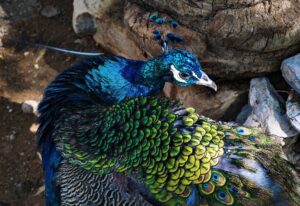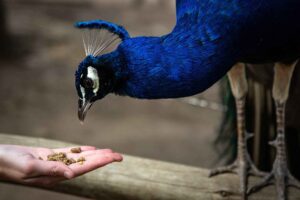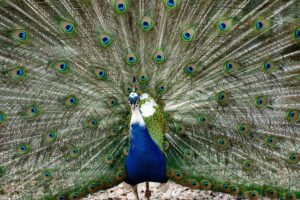Prepare to be enthralled as we delve into the enchanting realm of the peacock, a bird that has captivated the hearts and minds of people for centuries. The peacock is a creature of unparalleled beauty, celebrated for its resplendent feathers and remarkable displays of grandeur. It is the male of the species, the peacock, that takes center stage with its iridescent blue and green plumage and the iconic fan-shaped tail that leaves us spellbound.
Peacock feathers have been a source of inspiration for artists and fashion enthusiasts throughout history. The tail feathers, often called the “train,” can reach an astonishing length of up to six feet, adorned with an array of tiny, iridescent plumes that refract light into a breathtaking spectrum of colours. The train is not just a showpiece; it plays a vital role in the peacock’s courtship rituals. When trying to woo a mate, the male peacock raises its train and fans it out in a mesmerizing display while serenading its potential partner with a symphony of distinctive calls.

Beyond their captivating appearance, peacocks are renowned for their unique vocalizations, producing sounds reminiscent of a blend of honking and meowing. These calls can carry vast distances and serve as a means of communication between fellow peacocks. These majestic birds are incredibly social animals, often forming groups known as “parties.”
Although native to South Asia, peacocks have been introduced to various parts of the world due to their allure as ornamental birds. In the United States, you can encounter peacocks in zoos, farms, and even private estates. While they are not classified as rare, sightings of these extraordinary birds in the wild are relatively uncommon.
Regrettably, peacocks confront a series of challenges in their natural habitat. Habitat loss, driven by deforestation for agriculture and development, remains a significant threat to these birds in South Asia. Additionally, peacocks are hunted for both their meat and feathers, which hold immense cultural significance in some regions.

Nevertheless, there is a ray of hope for these magnificent creatures. In recent years, dedicated efforts have been undertaken to conserve peacock populations. These endeavours encompass habitat restoration initiatives and anti-poaching campaigns. Numerous zoos and conservation organizations are actively engaged in captive breeding programs to reintroduce peacocks to their native habitats.
Here’s a tidbit that might pique your interest: the term “peacock” is specifically used for the male of the species, while the female is known as a “peahen.” Another intriguing fact is that peacocks are omnivores, with their diet comprising a diverse range of foods, from insects and plants to small animals. While they are indeed capable of flight, their large and heavy feathers pose a challenge when it comes to covering long distances.
In conclusion, the peacock stands as a remarkable and captivating bird, renowned for its beauty and elegance. Its stunning characteristics, from the vibrant plumage to the distinctive vocalizations, establish it as a true marvel of the animal kingdom. Despite its widespread popularity, the peacock remains a rare and bewitching creature that continues to hold the fascination of people around the globe.

We hope you’ve enjoyed this journey into the fascinating world of peacocks. For those eager to learn more about these magnificent birds, we invite you to watch our video at “https://youtu.be/Y4L-YlB_Aos” where you’ll witness their splendour in action. Explore the natural wonders that surround us and continue to be inspired by the incredible diversity of life on our planet.
